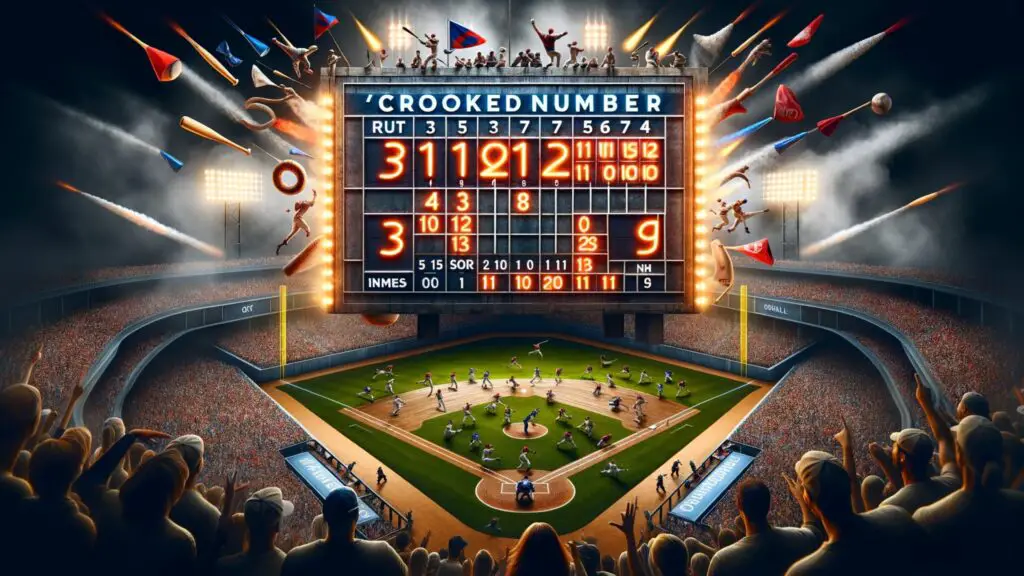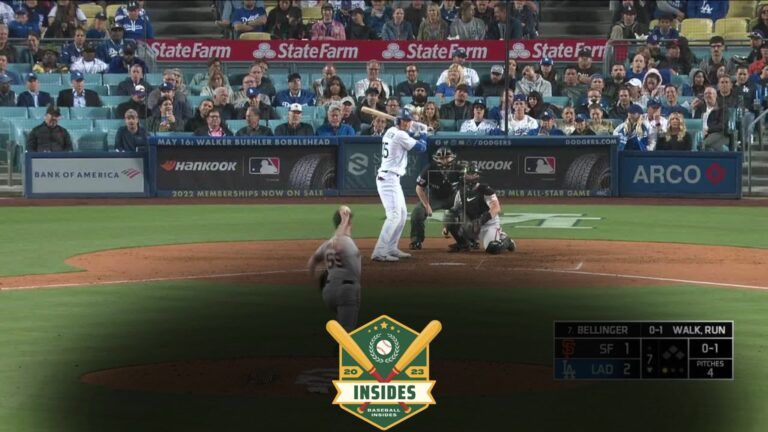
In this article:
Have you ever watched a baseball game and heard the announcer refer to a “crooked number”? You’re not alone if this baseball jargon has left you scratching your head.
It’s time to crack the code and let you in on this sport’s lingo secret.
So, what exactly is a crooked number in baseball?
A “crooked number” in baseball is any number other than zero or one that a team puts up in an inning. It denotes a successful inning where the team has scored multiple runs.
Baseball is a game packed with stats and figures. In fact, according to Major League Baseball (MLB), an average of 4.65 runs are scored per team per game. That means there are plenty of opportunities for those much sought-after crooked numbers!
Origin of the Term ‘Crooked Number’
Regarding baseball, a specific jargon gives the game its unique charm. The term “crooked number” is a quintessential part of this vocabulary, with roots deeply embedded in the sport’s history. But where did it originate?
The term “crooked number” is as old as the game itself or the scoreboards used to track the game’s progress.
It’s not entirely clear who first used the term, but it’s widely accepted to have developed in the baseball circles of yesteryear.
The theory behind the expression is quite simple. Look at a baseball scorecard – the numbers “1” and “0” are straight, whereas all other numbers are crooked.
This theory is supported by the term often used to indicate any inning in which a team scores more than one run.
There’s also an excellent layer of metaphor embedded within the phrase. In baseball, as in life, it’s generally more challenging to put up “crooked numbers”.
It requires teamwork, strategy, and a sprinkle of luck. The term, in this sense, becomes a poetic nod to the effort and collaboration needed to succeed in the sport truly.
While the exact origin of the term might remain a mystery, the enduring charm of “crooked numbers” in baseball is indisputable.
It’s a phrase that captures the spirit of the game, a blend of strategy, skill, and a touch of unpredictability.
While discussing the intricacies of baseball statistics, it’s also fascinating to delve into what RPI means in baseball, a metric that sheds light on a team’s strength of schedule and performance.
Difference Between Crooked Numbers and Straight Numbers
So, what’s the real scoop on the difference between crooked numbers and straight numbers in baseball? Well, it’s a lot simpler than you might think. The distinction all comes down to the score on the board.
Crooked Numbers
A crooked number in baseball refers to any inning in which the team scores more than one run. It’s a fun, colloquial term that captures the idea of the number not being ‘straight’ or singular.
Straight Numbers
On the other hand, a straight number refers to an inning in which just one run is scored. It’s straight, simple, and clean – just one run earned.
Think of it like this: Straight numbers are like solo home runs, while crooked numbers are like a grand slam. One is an excellent, tidy addition to the score, while the other has more chaos and excitement.
So there you have it! The difference between crooked numbers and straight numbers in baseball is a fun, quirky part of baseball lingo that all comes down to the score on the board.
Examples of Crooked Numbers in Baseball History
Have you ever wondered about those prominent moments in baseball history that featured crooked numbers? Well, sit back, and let’s take a trip down memory lane, revisiting some of baseball’s most notorious crooked number innings.
The Pittsburgh Pirates vs. Chicago Cubs (1954)
On August 14, 1954, the Pittsburgh Pirates put up an unforgettable display against the Chicago Cubs. The Pirates managed to post a whopping 12 runs in the seventh inning, firmly etching their names in the annals of baseball history.
The Boston Red Sox vs. Florida Marlins (2003)
One can’t talk about crooked numbers without mentioning the Boston Red Sox’s encounter with the Florida Marlins in 2003. The Red Sox exploded for a jaw-dropping 14-run inning, leaving spectators and Marlins alike in disbelief.
The Colorado Rockies vs. San Francisco Giants (1999)
Another notable mention was the game between the Colorado Rockies and the San Francisco Giants in 1999. The Rockies left the Giants reeling with 13 runs in one inning, a feat that is still remembered today.
The Toronto Blue Jays vs. Baltimore Orioles (1987)
The Toronto Blue Jays also deserve a shoutout for their performance against the Baltimore Orioles in 1987. They scored 10 runs in an inning, proving that baseball is a game of unexpected twists and turns.
These are just a few instances in a long list of games that featured crooked numbers. It shows that when the momentum swings your way in baseball, anything is possible!
How to Calculate a Crooked Number
Understanding how to calculate a crooked number in baseball is pretty straightforward. It’s less about complex mathematical equations and more about observing the game. Let’s dive right into it!
Observe the Inning
First and foremost, crooked numbers can only occur within a single inning. So, as you watch a baseball game, keep your eyes peeled on each inning as it unfolds.
Keep Track of the Runs
Next, you have to keep track of the runs. A run is scored each time a player advances around the bases and returns to home plate. You have a crooked number if more than one run is scored in an inning!
Remember the Rule
The key rule is that a crooked number in baseball refers to any inning in which more than one run is scored. If just a single run is scored in an inning, that’s simply a straight number, not a crooked one.
Look for the Crooked Numbers
Finally, look for the crooked numbers on the scoreboard. They are the numbers larger than one that appear under each inning. These numbers tell the story of the game’s momentum and can often predict the outcome!
Why Crooked Numbers Are Important in Baseball
You may wonder why crooked numbers are crucial in baseball. Well, let’s dive right into it.
The Value of Crooked Numbers
Putting a ‘crooked number’ on the scoreboard in baseball essentially means scoring multiple runs in a single inning.
It’s a term that captures the game’s unpredictability and the sudden shifts in momentum that can occur.
These numbers are important because they can significantly alter the balance of a game. They provide a psychological edge, often demoralizing the opposing team while boosting the scoring team’s morale.
Building Momentum
A crooked number isn’t just about runs, it’s about momentum. When a team posts a crooked number, it tends to generate a psychological shift, creating a sense of dominance and momentum that can be hard for the opposition to counter.
Remember: Baseball is as much a mental game as a physical one.
A Strategic Advantage
Posting crooked numbers can also influence game strategy. When a team is ahead by several runs, they can afford to take more risks, dictate the game’s pace, and force their opponents into difficult decisions.
Conversely, a team trailing by a crooked number may need to alter their approach, playing more aggressively to catch up or more conservatively to prevent further damage.
Influence on Pitching
Finally, let’s not forget the impact on pitchers. A crooked number can put significant pressure on the opposing pitcher, often leading to strategic changes, such as switching pitchers earlier than planned.
In essence, a crooked number is more than just a tally on the scoreboard; it’s an influential factor that can significantly shift the dynamics of a baseball game.
So, next time you watch a game, keep an eye out for those crooked numbers!
Strategies for Avoiding Giving Up Crooked Numbers
Regarding baseball, a team’s defensive strategy is often a high-stakes chess match. One wrong move, and you could end up surrendering a crooked number.
So, what are the best strategies for avoiding giving up these dreaded multi-run innings? Let’s dive in.
Maintaining Pitch Control
Pitch control is crucial. A pitcher who consistently throws strikes and avoids walks significantly reduces the chances of giving up big hits and, consequently, crooked numbers.
Emphasizing Defense
Another key strategy is to prioritize strong defense. This means having players skilled at fielding who can quickly react to prevent hits from turning into runs.
Pitcher-Batter Matchups
Understanding pitcher-batter matchups is another way to prevent crooked numbers.
By knowing a batter’s strengths, a pitcher can aim to exploit their weaknesses, thereby reducing the likelihood of giving up multiple runs.
Strategic Use of Bullpen
The strategic use of the bullpen can also help. A fresh pitcher may be more effective against a particular batter or in a high-pressure situation, ultimately helping to limit the number of runs scored in an inning.
Effective Game Planning
Effective game planning is yet another strategy to avoid giving up crooked numbers. This includes analyzing the opposing team’s tendencies, developing a pitching plan, and making in-game adjustments as necessary.
These strategies are not foolproof, but with careful execution, they can significantly reduce the chances of giving up crooked numbers and, in turn, increase a team’s chance of winning.
Understanding the game’s fundamentals, such as how many baseball players are on a team, can provide fans with a deeper appreciation of the strategy involved in fielding a competitive squad.
How Crooked Numbers Affect Momentum in a Game
Have you ever wondered what can truly turn the tide in a baseball game? Often, it’s not just a brilliant home run or masterful pitching but something called a “crooked number”.
This term might sound like it’s borrowed from a math class, but it carries a different meaning in baseball.
In baseball, a crooked number refers to any inning in which a team scores more than one run. In contrast, an inning where a team scores only a single run is often called a “straight number” inning.
Shift in Momentum
Now, you might wonder, how does a crooked number affect the momentum in a game? Well, it’s quite simple.
Scoring multiple runs in a single inning can dramatically shift the game’s momentum. It not only boosts the confidence of the scoring team but can also demoralize the opposing team.
Suddenly, the game isn’t just about individual scores but becomes a collective effort, leading to a surge in adrenaline and team spirit.
Psychological Impact
There’s also a psychological aspect to consider. Imagine you’re a player in the field, and the opposing team keeps scoring, run after run, all in one inning. It can feel like a punch in the gut, right?
That’s the psychological impact of a crooked number. It can significantly affect the morale and performance of the team in the field.
Strategy Shift
Finally, a crooked number can completely change both teams’ strategies. The scoring team might become more aggressive, while the opposing team may need to rethink their defensive and offensive tactics.
So, the impact of a crooked number goes far beyond the scoreboard; it plays a crucial role in the game’s dynamics and strategy.
Famous Games With Multiple Crooked Numbers
Every baseball fan loves a good comeback story, and when it comes to crooked numbers, boy, do we have some tales to tell!
Let’s take a trip down memory lane and revisit some of the most memorable games where multiple crooked numbers graced the scoreboard.
The ‘Slugfest’ – Yankees vs. Red Sox, 2009
Remember that epic game in August 2009? The Yankees and the Red Sox had a thrilling face-off, with both teams putting up multiple crooked numbers.
It was a slugfest of epic proportions, and the Yankees won 20-11. Now, that’s baseball at its finest!
The ‘Comeback Kids’ – Phillies vs. Dodgers, 1990
Take a moment to relive the Phillies and Dodgers game of 1990. The Phillies were trailing 11-1 at the seventh-inning stretch, but they didn’t go down without a fight.
They posted two crooked numbers in the late innings and eventually pulled off a remarkable 12-11 victory. What a comeback!
The ‘Record Breaker’ – Rangers vs. Orioles, 2007
How could we forget the Texas Rangers’ 30-3 victory over the Baltimore Orioles in 2007? The Rangers made history by posting crooked numbers in four separate innings.
This still stands as the most runs scored by a team in a single game in modern Major League Baseball history. Talk about a record-breaking performance!
These are just a few examples of games that saw multiple crooked numbers. And as any baseball fan knows, the excitement of these high-scoring games is unmatched.
So, here’s to many more crooked numbers lighting up the scoreboard in the future!
The Impact of Crooked Numbers on Team Morale
When a team posts a crooked number on the scoreboard, it could be a game-changer.
In baseball jargon, a crooked number refers to any inning in which a team scores more than one run. Essentially, it’s a visual representation of dominance and momentum.
The Morale Booster
Nothing lifts team spirit quite like a crooked number inning. It indicates that the team’s batting order is firing on all cylinders and dominating the opposition’s pitching.
This act of collective success gives players a sense of achievement and boosts morale significantly.
The Momentum Swing
From a psychological standpoint, a crooked number can be a momentum swinger. The sudden surge of runs can demoralize the opposing team while injecting a new level of confidence and belief into the scoring team.
This shift in momentum can have a profound impact on the rest of the game.
The Role of Crooked Numbers in Comebacks
Posting a crooked number can spark a potential comeback when a team is behind.
Breaking the one-run barrier in an inning can rejuvenate a trailing team and instill a ‘never-say-die’ attitude among players. In essence, a crooked number can serve as a beacon of hope.
Creating a Winning Atmosphere
Consistently putting up crooked numbers can create a winning atmosphere within a team. It’s a testament to the team’s offensive prowess and can make players feel invincible.
This positive environment is crucial for maintaining high team morale throughout the season.
Crooked Numbers and Their Impact on Statistics
When it comes to the world of baseball, crooked numbers are more than just a numerical oddity.
This term carries a lot of weight and can significantly impact the overall statistics of a game. But what exactly does it mean, and why is it so important?
Understanding Crooked Numbers
In baseball lingo, a ‘crooked number’ refers to any inning in which a team scores more than one run. In contrast, innings, where a team scores a single run, are called ‘straight numbers’.
The term is quite illustrative, as the numbers 2, 3, 4, and so forth appear ‘crooked’ compared to the straight, singular value of 1.
Impact on Game Statistics
The occurrence of crooked numbers can drastically influence the statistical dynamics of a baseball game.
Teams that consistently put up crooked numbers are often seen as strong offensive forces capable of breaking wide-open games.
Conversely, teams frequently allowing crooked numbers are seen as having defensive challenges.
The Strategic Importance
From a strategic perspective, crooked numbers are highly coveted. Managers and players strive to put up as many crooked numbers as possible, often leading to a substantial lead that can be difficult for the opposing team to overcome.
Therefore, understanding and utilizing crooked numbers can be key to gaining a competitive edge.
Famous Players Are Known for Producing Crooked Numbers
When we dive into the world of baseball, we encounter a myriad of stars that have consistently put up crooked numbers.
Through their exceptional performance, these athletes have etched their names in the annals of the sport.
The output of such players during their careers has set them apart from their peers.
Babe Ruth
First up is Babe Ruth, the legendary figure whose name is synonymous with baseball. Ruth, fondly known as “The Bambino” or “The Sultan of Swat”, accumulated crooked numbers that still astound sports enthusiasts worldwide.
His career tally of 714 home runs and a batting average of .342 testaments his ability to inflate the score.
For those curious about the nuances of pitching and game strategy, exploring what is a hold in baseball can offer insights into how middle relievers contribute to a team’s success in tight situations.
Hank Aaron
Next in line is Hank Aaron, whose illustrious career spanned 23 years. Aaron put up such crooked numbers during this period that he broke Ruth’s long-standing home run record.
His remarkable tally of 755 home runs has made him a revered figure in baseball.
Barry Bonds
Last but not least, we have Barry Bonds on our list. Bonds, known for his prodigious power and unmatched eye for the ball, produced crooked numbers.
With an unparalleled career total of 762 home runs, Bonds surpassed Aaron’s record, etching his name in baseball history.
These players’ extraordinary ability to consistently rack up crooked numbers is undeniably a significant factor in their legendary status in baseball.
Their memorable performances will forever remain etched in the hearts of baseball fans worldwide and will continue to inspire generations of players to come.
How Crooked Numbers Can Make or Break a Team’s Season
Every baseball enthusiast knows that one run can dramatically change the course of a game. But when we start talking about crooked numbers, we raise the stakes even higher. These are the scores that can make or break a team’s season.
The Impact of Crooked Numbers
In baseball parlance, a crooked number refers to any number other than zero or one that appears on the scoreboard in an inning. The multi-run innings can transform a game and send a team on a victorious trajectory.
The more crooked numbers a team can put up, the better their chances of winning.
But they’re not just game changers – crooked numbers can be season changers, too. A team consistently puts up crooked numbers throughout the season can find themselves with an enviable win-loss record when the final game is played.
How Teams Strategize for Crooked Numbers
Teams don’t just stumble upon crooked numbers – they result from strategic planning and execution.
For a team to score multiple runs in an inning, there needs to be a combination of successful hits, smart baserunning, and, sometimes, a little luck.
Coaches and players spend hours studying their opponents, strategizing how to maximize their offensive output in each inning.
It’s a chess match of the highest order, with each move potentially leading to a crooked number on the scoreboard.

FAQs
1. What is a Crooked Number in Baseball?
A “crooked number” in baseball refers to any number other than zero or one. It is generally used in the context of the number of runs scored in an inning.
2. Why is It Called a Crooked Number?
The term “crooked number” comes from numbers other than one, and zero is not straight when written down, hence the name ‘crooked’.
3. Is Scoring a Crooked Number Good or Bad?
Scoring a crooked number is usually good for the scoring team, as it indicates multiple runs in an inning. Obviously, for the opposing team, it’s not as favorable.
4. How Often Do Crooked Numbers Occur in a Game?
Scoring a crooked number in an inning is not common in every game. It depends on the team’s performance and the game’s dynamics.
5. Can Both Teams Score a Crooked Number in the Same Inning?
Yes. Both teams can score a crooked number in the same inning, provided both teams can score more than one run in that inning.
6. Is There a Limit to the Crooked Number That Can Be Scored?
There is no limit to the crooked number that can be scored in an inning. Theoretically, a team could score any number of runs.
7. Does a Team Always Aim to Score a Crooked Number?
While scoring a crooked number can provide a significant advantage, teams do not necessarily aim for it. The immediate goal is always to score runs; if multiple runs come in an inning, it’s a bonus.
8. Is the Term “Crooked Number” Used in Other Sports?
The term “crooked number” is largely used in baseball. While it may be used informally in other sports, it is not a standard term outside baseball.
9. Who Coined the Term “Crooked Number”?
It’s unclear who exactly coined the term “crooked number”. It’s been used in baseball lingo for decades, adding an interesting twist to the sport’s rich vocabulary.
10. How Can I Use “Crooked Number” in a Sentence?
An example is: “With that home run, the Yankees have put a crooked number on the board in this inning.”
Conclusion
In conclusion, crooked numbers are more than just numbers on a scoreboard. They’re a testament to a team’s offensive prowess, strategic planning, and ability to seize an opportunity when it presents itself.
Next time you watch a baseball game, watch those crooked numbers – they might determine who walks off the field as the winner.






